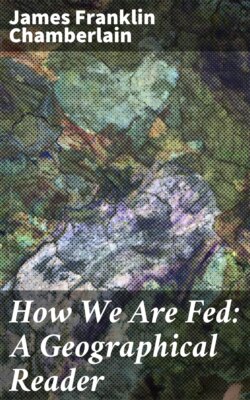Читать книгу How We Are Fed: A Geographical Reader - James Franklin Chamberlain - Страница 3
PREFACE
ОглавлениеIn the ordinary course of events, most individuals take some part in the manifold industries which engage the mind and the hand of man, by which alone our present-day civilization can be maintained. These great world activities touch the daily life of every member of society, whether child or adult, worker or idler.
A chain of mutual dependence, too often unrecognized, binds together the members of the human family, whether they belong to the same community or dwell on opposite sides of the earth. The links of this chain are made up of the articles which constitute our daily food, our clothing, homes, fuel, light, our means of communication and transportation, and only by continuous coöperation are they kept together.
The highest motive in education is to present the conditions which will lead to the most complete living; to build up the best possible members of society; to develop character. An individual who does not understand the life of which he finds himself a part, cannot be in full sympathy with its conditions and hence cannot be of the most service to himself or to others. Only to the extent that education and life follow the same general course, can each be truly successful. Far too little is done in our schools to acquaint children with their relations to the great industrial and social organization of which they are members. Even grown persons have, as a rule, a very indefinite knowledge of these relations.
It is a recognized principle that our knowledge of geography has its foundation in our knowledge of the home. The natural connecting link between the immediate surroundings and the outside world is the present daily life of the home. Through the industries seen in the community, the commodities in general use, and the history of their creation and supply, the pupil acquires an insight into the life about him as well as into that of other parts of the world. He also realizes the great truth that the world and its people are in intimate touch with him. In this way he is led back and forth along the routes which civilization has followed in its progress, which it also follows to-day, as mankind clasp hands across oceans and continents. Thus the remote and abstract become immediate and concrete. Facts are seen in a setting of reason, and a logical and interesting basis for the study of physical, climatic, and human conditions is furnished.
This study begins with the commodities in constant use and finally encompasses the whole world, but always with the home as the base of operations. It will create a knowledge of the interdependence of individuals, communities, and nations, and a genuine respect for the work of the hands and for the worker. The importance of this respect is not likely to be overestimated. Without it a true democracy cannot long exist.
Reading should not only serve for the acquisition and the expression of the thought contained in the printed page; it should, in addition, stimulate to new thought—to independent power in reasoning. On this account questions are inserted which the pupil is left to answer. These are suggestive of a much larger number, which should be worked out by the teacher. Too many of the questions found in books do not "stimulate thought" or "independent power in reasoning." They are purely informatory and not at all formative.
No attempt has been made to treat every article of food. Those in most general use, as well as those which will best serve to develop a knowledge of geographical conditions and of man's relation to man, have been chosen.
A given industry is pursued in somewhat different ways in different places. It has not been thought wise to describe each modification in these pages. For example, the method of handling wheat in California is different from that employed in Minnesota. The value of the work will be increased if the teacher will bring out these points.
All places mentioned should he definitely located, both as to position on the map or globe and with reference to the home. When developed from the standpoint of direct, personal interest, a knowledge of the location of places as well as of other facts mentioned is most likely to be retained.
The illustrations used have been very carefully selected for their teaching value. They give a clearness to mental pictures which can be derived only through observation of that which the illustrations symbolize. Much experience in the use of geographical illustrations has shown that pupils need to be directed in their examination of them. To secure the best results they must be made the centers of thought-developing questions.
Thanks are due the Pillsbury-Washburn Flour Mills Company of Minneapolis, the Swift Packing Company of Chicago, the Walter Baker Company of Dorchester, the United Fruit Company of New Orleans, and Dr. Charles U. Shepard of Pinehurst Plantation, for the excellent illustrations furnished by them.
JAMES FRANKLIN CHAMBERLAIN.
State Normal School,
Los Angeles, March, 1903.
